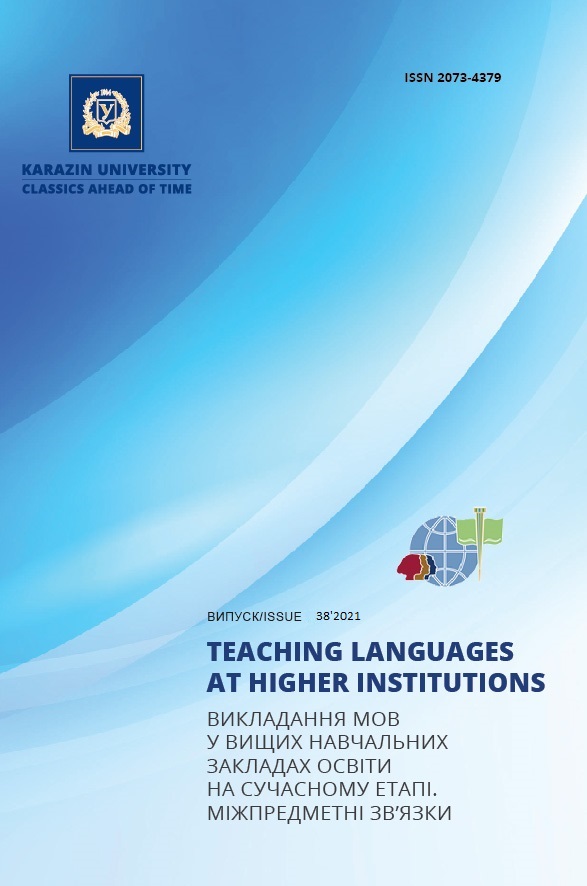Localization of conceptual information in intercultural dialogue
Abstract
This paper deals with one aspect of mitigating barriers to communication that arise from misunderstandings of the conceptual meanings of national-specific lexical units in the context of university education. The localization of the conceptual information is recognized as a means of such mitigation.
The objective of the article is to prove the possibility of applying the term and procedures of localization to the linguistic and cultural interpretation of the conceptual national specific vocabulary for the intercultural dialogue. Whatever the substantive or socio-ethical goals of intercultural dialogue, its purpose is to develop the cognitive system of its participants. Each producer of a dialogue builds its own trajectory of knowledge actualization, relying on its inherent mental and cultural experience, which has been transmitted or formed in contact with the environment, especially in the educational domain. The dialogue becomes a medium of perception, cognition, comprehension, and cognitive adaptation of the cultural and semantic information which is carried by the word-concept, i.e. the problem of localization of conceptual information within another language and culture will be solved. The methodological principle of the research was a combination of cognitive approach to conceptual vocabulary understanding with hermeneutic and linguistic and cultural analysis.
To get a better idea of localization in the article, as a methodological technique during the deployment of intercultural dialogue, the author proposes some national-specific linguistic units from the poem “Aeneid” by Ivan Kotlarevsky. Such units form conceptual information and can be part of the dialogue system in various disciplines at Tunisian language institutions of higher education. Specific examples illustrate, as a result, the theoretical assertion that there is a need to study in depth the conceptual information that helps reduce disruptions in the “communicant-communicant” relationship and avoid breaking the communication line in a dialogue.
Downloads
References
Bahtin, M. (1975). Voprosy literatury i estetiki. Issledovaniya raznykh let. Moscow: “Hudozhestvennaya literature” [in Russian].
Virgilieva Eneida na malorosiyskiy yazyk perelozhennaya I. Kotlyarevskim. (1842). Ch. I-VI. Kharkov: V Unyversytetskoj Typografii [in Ukrainian].
Gavrylyuk, X.Yu. (2014). Pereklady “Eneyidy” Ivana Kotlyarevskogo: interpretaciya nacionalnoyi ta svitovoyi mifologiyi [Translations of Ivan Kotlyarevsky’s Aeneid: interpretation of national and world mythology]. Extended abstract of candidate’s thesis. Odesa: South Ukrainian National Academy of Sciences. Pedagogical University named after K. D. Ushinsky [in Ukrainian].
Levchenko, O.P. (2005). Frazeologichna symvolika: lingvokulturologichnyj aspect [Phraseological symbolism: linguistic and culturological aspect]. Lviv: LRIDU NADU [in Ukrainian].
Maliksetyan, E.V. (2002). Reklama kak sociokulturnyj fenomen: dialektika globalnogo i lokalnogo [Advertising as a socio-cultural phenomenon: The dialectic of the global and the local]. Doctor’s thesis. Krasnodar: Krasnodar State University of Culture and Arts [in Russian].
Prokhorov, Ju.E. (2009). V poiskah koncepta. Moscow: FLINTA: Nauka [in Russian].
Plungyan, V.A. (1991). K opisaniyu afrikanskoj “naivnoy kartiny mira” (lokalizaciya oshhushheniy i ponimanie v yazyke dogon) [On description of the African “naїve world picture” (localisation of feeling and understanding in Dogon language)]. Logicheskiy analiz yazyka. Kulturnye koncepty. Moscow: Nauka [in Russian].
Frazeologichnyj slovnyk ukrayinsoyi movy [Phraseological Dictionary of the Ukrainian language]. (1993). Bilonozhenko, V.M. ang others (Comps.). Kyiv: Nauk. dumka [in Ukrainian].
Barrett, M. (2016). Competences for democratic culture and intercultural dialogue: A new comprehensive competence and some ethical challenges for assessment. Intercultura, 80, pp. 8–12 [in English].
Ferrari, G. (2019). Localization of advertisements: translation or cultural mapping? Translation Studies: Retrospective and Prospective Views, 22 (XII), pp. 28–41 [in English].
Gerritsen, M., Nickerson, C., van Hooft, A., van Meurs, F. and Korzilius H. (2010). English in Product Advertisements in Non-English-Speaking Countries in Western Europe: Product Image and Comprehension of the Text. Journal of Global Marketing, 23 (4), pp. 349–365 [in English]. DOI: 10.1080/08911762.2010.504523.
Mangiron, C. (2017). Research in game localization: An overview. The Journal of Internationalization and Localization, Volume 4, Issue 2, Jan 2017, pp. 74–99 [in English]. DOI: https://doi.org/10.1075/ jial.00003.man.
Nielsen, J. (1990). Designing User Interfaces for International Use. North Holland [in English].
Wermuth, M-C. (2016). Language localization in scientific drug information. The Journal of Internationalization and Localization, Volume 3, Issue 1, pp. 74–94 [in English]. DOI: https://doi.org/10.1075/jial.3.1.05wer.

